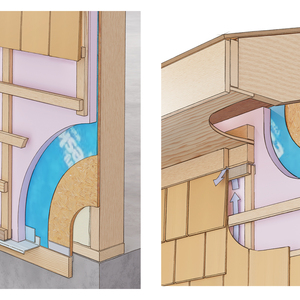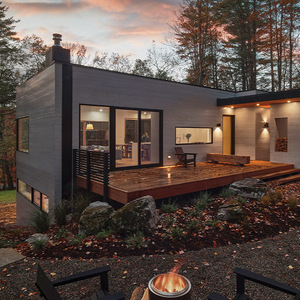*
Help… Jeff is beating on me to finish the specs…
OK.. 14′ x 26′ garage with 2×10 joists.. how do i insulate?..DP? or High Density F’brglas.. the ceiling will be 5/8 type X with skim coat so I can blow… but what about settling?
Discussion Forum
Discussion Forum
Up Next
Video Shorts
Featured Story

There are some instances where multiple minisplits make sense.
Featured Video
Video: Build a Fireplace, Brick by BrickHighlights
"I have learned so much thanks to the searchable articles on the FHB website. I can confidently say that I expect to be a life-long subscriber." - M.K.
Fine Homebuilding Magazine
- Home Group
- Antique Trader
- Arts & Crafts Homes
- Bank Note Reporter
- Cabin Life
- Cuisine at Home
- Fine Gardening
- Fine Woodworking
- Green Building Advisor
- Garden Gate
- Horticulture
- Keep Craft Alive
- Log Home Living
- Military Trader/Vehicles
- Numismatic News
- Numismaster
- Old Cars Weekly
- Old House Journal
- Period Homes
- Popular Woodworking
- Script
- ShopNotes
- Sports Collectors Digest
- Threads
- Timber Home Living
- Traditional Building
- Woodsmith
- World Coin News
- Writer's Digest


















Replies
*
Mike,
Have you done Dense-pack before? One advantage is that it doesn't settle. If you need to know more, ask. I just assumed from your active participation in cellulose discussions that you've done dense-packing before.
You've got living space over a garage, is that correct? It's critical not to have holes in the living space that will draw replacement air from the garage. CO and all. To that end, what ever you can do to get the best air-seal on living space above is good.
Steve
*Steve..I sub half our insulation.. all of the cellulose.. and I always use the same sub..we do about half of our own Fiberglas... and anything to do with rigid or below slab..i understand and have seen DP in Walls and Cathedral ceiling (sloped)..now here's a new twist..flat bays overhead.. insulated from below... 3.5 lb/cf? when do you start blowing the board off the ceiling?5/8 type X, remember?i can have the 2d floor blower door tested and foam any penetrations , so i'm not worried about garage fumes..mostly looking for recommendations on nozzle size, number of holes, bag count/cf, the usual.. as you know ,, DP is a technique that requires an experience factor, because you can't inspect it, so you need other safeguards and knowledge to insure a good job...want to know what you guys that work with DP all the time can share..
*.... Steve... and anyone else .. still looking for help on this floor insulation..... before comming to BT i had never considered DP as a possibility for floors....have you or anyone out there actually done DP in floors as described above? is this something i can do or do i go back to my normal High-density fiberglass batts for this section....Mike
*Hi Mike,Before coming to BT I had never heard of DP cells. So far I've only done walls, but ceilings go the same way. According to FredL, who has done lots of it, 5/8 sheetrock on 16" centers should not blow off or bow at the pressure you'll be exerting. Don't strap the ceilings or you'll decompartmentalize the bays, making it impossible to get high density.Drill a 4-inch hole at one end of the bay or leave a 6" strip of sheetrock open between two sheets that span the bays or at the end of the bays. A hose that's in the vacinity of 1 1/2 inches ID works best. I've used 1" and 2" too. Anyway, set the machine to blow very lean (lots of air, small amount of cells), run the hose all the way in to the end of the bay, blow till machine stalls, back hose out about a foot whereupon it should un-stall, wait for it to stall again, repeat till you've backed all the way out of the bay. This should get you in the vacinity of 3 or 3 1/2 lbs/CF. At the 8-foot-off-the-floor level you'll have in the garage ceiling, the pressure differential isn't that great, so it's not that critical. Plus you are working new construction so each bay will be a pretty uniform six-sided box to start with, which is pretty air-tight already. The DP cells will pretty much take care of sealing any pentetrations or framing irregularities. Ron Schroeder has done some testing on his own and finds that anything over 2 1/2 lbs/CF doesn't settle. Again, according to Fred, air-sealing supposedly commences at 3 lbs, at which point it's safe to lose the vapor barrier. 4 lbs is best for high pressure differential areas such as the attic of a tall building with leaky construction.To figure out just how much you are really getting in, count the number of bags and calculate the volume you've filled with them. Do a quick check after the first couple of bays to make sure you are getting the density you want. If you need higher density lean it out more. For lower density richen the mix. Then you are home free. Hope this helps. Maybe Fred or Ron Schroeder are lurking and will chime in.Steve
*...Thanks , Steve, I'll be talking to my insulator and let you know if i need any more info.....
*Mike - I did my attic floors - pulled off one 1X6 down the center and worked both ways. 16" on center 2X6 roughs with plaster and lath ceiling below. Mark tube so you know how far in you are. I spent a day with machine trying things. Called Fred for help because I couldn't get mixture lean enough to dense pack and he gave me some ideas for modifying the machine which worked. After that I was able to move quite quickly - or at least I thought so.Don't know the building but if sides (ends of joist bays) are exterior and not yet sided - consider coring holes in the band sill and attaching a rigid pc of pvc to the hose and working from outside after drywall is complete and at least first coat taped.Lookout for openings - I ended up with 20 pounds of fuzz in a spare room where one wall cavity was opened. Swept it up and blew it in later.Good luck.
*Steve (and all). I'd also like to use dp for my garage."air-sealing supposedly commences at 3 lbs, at which point it's safe to lose the vapor barrier"Fair enough for walls and closed spaces. How do you get to this density in un-enclosed ceiling spaces? (my garage is truss roof with no usable 2nd floor space)
*If you can't use it why not just seal with foam and caulk and blow cells not dense? I think it would be easier but I have read of using housewrap, battened to the joists or lower chords in this instance and then blown dense - kind of pillow like. I don't think I'd try this but could work. In review, you can't dense pack without enclosing and a cavity with a cross section of around 1' by 2' seems to be the practical limit.
*If you spray Icynene (or any spray foam) on the underside of the floor (max 5-1/2"), you'll get the insulating value and the airseal you need for this application.
*Scott,In your case I would manually air seal with foam gun (use a vapor barrior or not depending on how well you think you've sealed everything up) and blow in 2 feet of loose cells. It'll settle down about 30%.Steve
*Variation on theme. The wall separating our garage and basement (a workshop and a storage room and a hallway) is the thickness of a 2 x 10, but is framed with two sets of 2 x 4's w/ a 2 1/2" space. Framed this way because all utilities enter on this wall, and it gave the wires and plumbing room to run w/o drilling holes. Garage has no garage doors--just drive-in openings. Weather is North Carolina mountains.So, what's preferred here: dense-pack cellulose or batts or other? If DP, then what modifications to DP instructions because of the openness of the framing (not having "uniform six-sided boxes")?Also, will 1/2" sheetrock on 16" centers hold DP?Thanks, I'm learning a lot.
*Do yourself a favor and specify rigid sheathing above all your drop soffits as well. Especially if they are attached to the garage.There are people who believe that DP cellulose still convects through it if the pressures are high enough. So make damn sure the kitchen ceilings are not directly attched to the garage ceiling.-Rob
*geeesh, rob, thanks fer the tip... i guess u must think i'm a ejeet...but, hell, yeh.... NO connections or short circuits between the garage and the habitable spaces....
*Jim k .. to analyze yur situation..wats the design temp on each side of the wall..is it 70 on one side and 10 on the other.. or 50 on one side and 20 on the other?see if the delta T is 60 deg. then wat u do may be worthwhile..if its only 30 deg. then i wouldn't expend too much energy or money..i'd also think about enclosing the rest of the garage as an energy conserving measure..your wall is 3.5+2.5+3.5 = 9.5 inch thick x ((something ) x ((something)) = CF.... at say 3 lb. / CF will tell you how many pounds of cellulose.. versus say double unfaced R-11 batts of fiberglass with a 6 mil poly vapor barrier.....u figger it and draw ur own conclusions..just make sure yur gonna ((keep yur powder dry)),,,,ie: take care of any moisture sources and either solution should be fine..
*Damn Rob!! Mike and I could have already had this thing built had you come up with that detail six weeks earlier.Full speed ahead Mike. Vacations over.[G]Jeff
*Maybe I'm thick - were you two busting on me?It may have been stating the obvious, but it happens all the time. Here's a prime area where the codes are a particular pain in my neck. In our area you MUST have one step up from the garage. But no one will ever come back and see if you are drafting garage air in through the ceilings!!Go figure.-Rob
*
Help... Jeff is beating on me to finish the specs...
OK.. 14' x 26' garage with 2x10 joists.. how do i insulate?..DP? or High Density F'brglas.. the ceiling will be 5/8 type X with skim coat so I can blow... but what about settling?